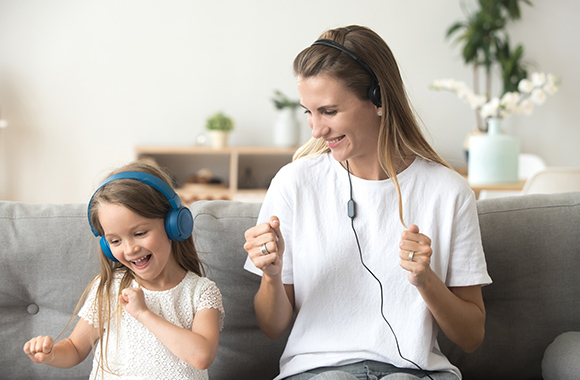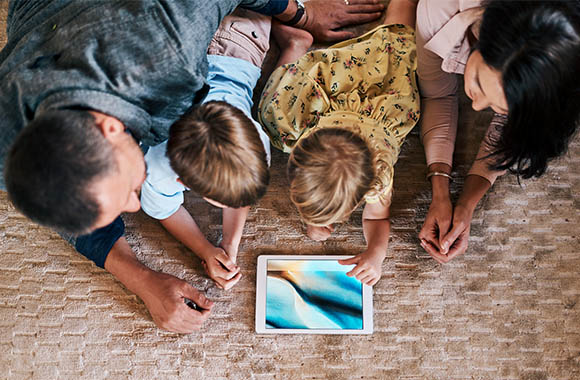Digital parenting: Explore digital media with your children
Digital media have become an integral part of our lives and therefore have a considerable impact on our everyday routine. Especially in everyday family life, it is important to handle media in a sensible and reflective way and explore the digital world together with your children. As your child gets a feel for digital media, the entire family can benefit from shared media experiences and strengthen family ties. We have tips for you how to enrich your family time with media and explain why shared media consumption may enhance the development of your child.
Find a summary of the most important information and tips about media literacy for children in our media guidelines.

Contents
How do children perceive media?
Small children and elementary school children perceive the world and activities in their surroundings differently compared to their parents. Their attention span is still limited, and they cannot fully understand how different factors may relate to each other. Therefore, children cannot easily “filter” the media they are confronted with. Learning how experiences and images should be interpreted and put into context is part of growing up. For your child to gain important experience, all senses need to be activated for full cognitive awareness of the environment. It is therefore recommended not to confront children too early with digital media so that real life experiences do not get cut short. During the first years of life, children perceive digital media mainly as a source of irritation. Flashing lights and loud noises draw the attention of small children without them understanding the message or meaning.
It is therefore important that parents are aware of this, and that they support their children with purposeful and playful media use guidance. Especially because we are surrounded by digital media in our everyday lives, it is recommended that you live by example and reflect upon your own media use.
With growing age, the attention span of your child increases and, for example, TV shows may become more interesting. Normally, older elementary school children can already follow longer films easily and get excited by educational shows. They can tell the difference between a film and an advertising clip, and now they are receptive for advertising messages. Therefore, you should teach your child how to handle advertising properly and thus keep advancing his or her media literacy.
Shared media use in the family
Children develop media literacy by trying out different media. Here, it is helpful when they are supported by their parents and playfully learn more about media and get a feel for them.
All age groups benefit from having access to plenty of other activities and alternatives to digital media. A stimulating environment away from media can satisfy your child’s need to move and explore. Support the individual interests and talents of your child in various areas such as music, dancing, painting or sports. Also plan for regular playtime with peers.
In the following, we provide ideas and recommendations for which media are suitable for the age of your child, and how you can use them within your family sensibly and purposefully, but also playfully and creatively. This way you can learn together, have fun and practise using media responsibly.
Reading, painting and explaining pictures: Children aged 0-2 years
Babies and small children should not be directly confronted with digital screen media such as TVs, laptops or smartphones. They do not yet comprehend what they see and only react to acoustic and visual stimuli. However, babies notice what their parents focus on. They communicate with their eyes which has a positive effect on the relationship between parents and their children and increases trust. If parents often focus their attention on smartphones, TVs and the like, then this important eye contact can no longer be established.
By six months of age, picture books become the most important medium for your child. From this age on, you can read more and more to your child and explain the illustrations. Motivate your child to describe the illustrations – even if these are only the first attempts of proper speech and perhaps only single words – and encourage pointing at objects. This way you can spend a lot of time with your child, enhance speech development and accompany your child during the first steps into the world of media.
A few recommendations on how much time your child should actively spend using media and which rules you should consider and implement are assembled in our article “Screen time recommendations”.
A few recommendations on how much time your child should actively spend using media and which rules you should consider and implement are assembled in our article “Screen time recommendations”.
First steps in the world of digital media: Children aged 3-5 years
For toddlers and preschool children, it is more and more important to have active contact with their surroundings as well as a lot of playtime in order to explore the world and make discoveries. In this context, books are usually the main hub for the media world. When reading to your child, encourage your child to take an active part and try listening actively as well. Talk to your child about the pictures and or come up with an alternative ending of the story. Communication is the key to process the contents and to learn from it. By asking targeted questions you encourage your child to reflect on the content and you support developing a feel for language, creativity and communication capacities.
With increasing age, you can slowly introduce screen media to your shared activities. Digital picture books or the picture gallery on a smartphone are opportunities to try out a touch screen. Your kids can look for people they recognizes or take part in a short Skype conversation with their grandparents. This shows that media can also be used actively. You can also watch short, age-appropriate TV shows together with your child and talk about the contents presented on the screen.
When your child has reached pre-school age, he or she can also handle longer stories without pictures. Therefore, you should continue reading to your child and offer short audio plays as well. Talk about the plot and characters, try and think of alternative endings or paint scenes of the story. This is fun and enhances proper listening. Find detailed recommendations for child-oriented audio and screen media here.

Toys with digital access can also playfully introduce your child to the world of media. Playing together and trying out the app functions allow you to explore the options of digital media.
Toys with digital access can also playfully introduce your child to the world of media. Playing together and trying out the app functions allow you to explore the options of digital media.
Enhance creativity using media: Children aged 6-7

Every day, young elementary school children train their attention span at school and are therefore ready to follow longer plots. They are now more interested in age-appropriate children’s and educational programmes. Watch these shows together with your child and discuss what you have seen and learnt. Ask specific questions about the plot and encourage your child to come up with his or her own interpretation and opinion about the content. This way, your child learns to reflect what he or she has watched and, together, you can clarify remaining questions.
At this age, children can also learn to use media to further their own creativity. With an age-appropriate camera or a recording device, your child can produce short reports and find creative ways to capture their environment. You can show your child on a computer or a tablet how to edit the photos or videos (cut, turn, draw etc.). Together, you can think of themes for future photos, admire the pictures and even organise them in an album. Accompany your child on his or her first adventures. As soon as he or she is comfortable using the camera and starts to enjoy capturing images, you can also give permission to go and explore the surroundings independently.
Experience films, computer and the internet together: Children aged 8-10 years
Typically, digital media moves more and more towards the centre of attention for children of this age group. At this stage, they can follow complex plots much better and learn to apply their own criteria of quality for films, tv shows or the like. Speak to your child about the reasons why he or she enjoyed a film, a character or a story and which aspects were perhaps less appealing. Thus, your child slowly discovers their personal taste, and you can find out more about his or her interests and preferences.
Longer audio plays are now also suitable for your child. You can listen to them together and do something creative afterwards: Replay a scene, think about what could have happened after the end or even record your own audio play. Creative media use trains media literacy and imagination.
Now, you can also slowly start exploring the computer and the internet together. On age-appropriate pages and search engines you can look for suitable websites or look at funny animal pictures. You can also prepare a short quiz for your child and come up with the answers to the questions together. Thus, your child will not only learn how to use the internet properly but will also find lots of new information about the world. Your child does not have to explore child-oriented video games alone either. Sit together at the computer and enjoy playing a game. Some games are even suitable to improve your child’s reaction ability and hand-eye-coordination.
There are age rating systems for films, apps and video games. These labels make recommendations on which media are appropriate for your child.
There are age rating systems for films, apps and video games. These labels make recommendations on which media are appropriate for your child.
Smartphones and social media: Children aged 11-13 years
Your child is now exploring and developing their personality more and more. This includes developing his or her individual taste and opinions that may intentionally differ from others. During this age, children typically spend more time alone – you should give your child the freedom to do so. This does not necessarily mean that you no longer spend any time together. Media may help you find new topics of interest that you can experience and share as a family. Inform yourself about the favourite characters of your child or have him or her explain them to you.
Computer and console games could be something you can both enjoy together. Have your child explain to you how to run the controls and spend time together doing something your child enjoys. For example, child-appropriate platform games improve the reaction ability and train the ability to deal with failure. If you compete against each other, your child will learn to act appropriately in competition and internalize the rules of fair play.
Increasingly, social media and smartphones gain in importance. Talk about how to be safe in social media networks and which rules are important to observe. Exchange interesting websites, send photos or funny jokes from the internet – this way your child gets introduced to social media networks in a playful way and you remain in contact online.
Summary
Digital media provide your families with many options to exchange ideas and share activities. They introduce new topics to talk about, ideas for new games, creative hobbies and shared media experiences. These experiences strengthen family ties and, at the same time, enhance your child’s media literacy. You should always pay attention to responsible media use, age-appropriate contents and, of course, sufficient opportunities to stay occupied outside the digital world.
Sources and further reading
https://www.readingrockets.org/article/children-and-media-tips-parents
(accessed on 12 February 2022)
https://childmind.org/article/media-guidelines-for-kids-of-all-ages/
(accessed on 12 February 2022)
https://www.ourfamilywizard.com/blog/
(accessed on 12 February 2022)
Image sources
iStock.com/skynesher
iStock.com/Geber86
iStock.com/fizkes
iStock.com/PaulBradbury





